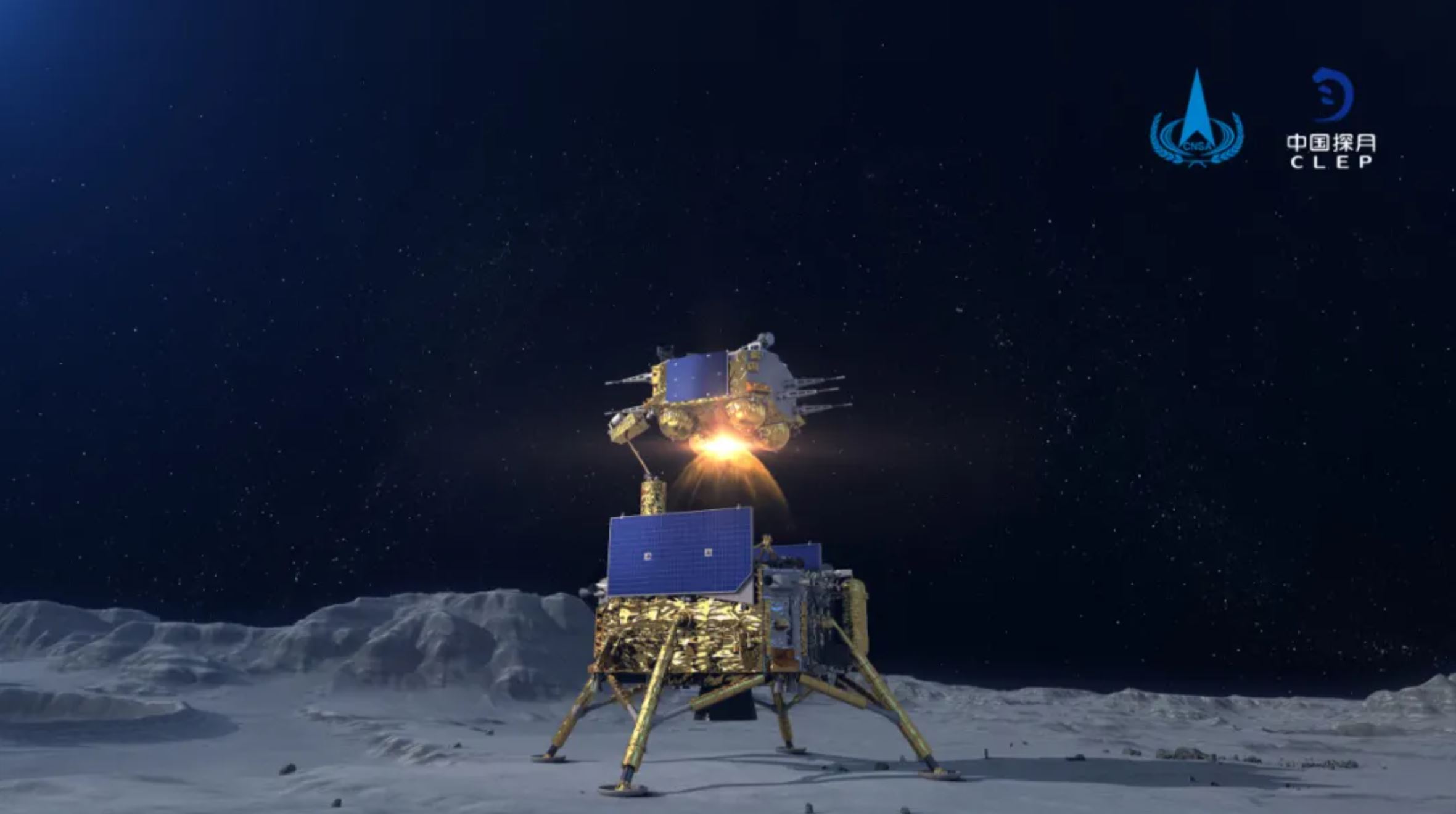China's Chang'e 5 probe lifts off from moon carrying lunar samples
Chang'e 5 has collected the first fresh moon samples in decades.
China has launched a small spacecraft from the surface of the moon in the critical next step in the ambitious Chang’e 5 mission to bring lunar samples to Earth.
The small probe, which sat on top of the Chang'e 5 lander, lifted off from Oceanus Procellarum at 10:10 EST Thursday (15:10 GMT/23:10 Beijing time) carrying with it the first fresh lunar samples since 1976.
Six minutes later, the ascent spacecraft achieved lunar orbit, marking a huge milestone in the Chang'e 5 mission to return lunar samples to Earth. The ascent vehicle's job now is to meet up with the Chang'e 5 orbiter while still circling the moon, and then transfer its precious cargo to a return capsule for the journey home.
Video: Watch China's Chang'e 5 mission land on the moon

That next stage is an extremely challenging rendezvousing and docking between the small ascent vehicle and the Chang'e 5 orbiter while orbiting the moon. The activity needs to be automated due to the time delay in communicating across the roughly 236,000 miles (380,000 kilometers) between the Earth and the moon.
The two spacecraft will begin a final approach sometime on Saturday (Dec. 5) and complete the docking 3.5 hours later. If all goes well, China will then prepare for the final leg of the journey to deliver the first lunar samples to Earth in 44 years.

The lunar samples won't be coming home immediately however. The Chang'e 5 spacecraft will need to wait in lunar orbit for a number of days for a narrow window in which to fire its engines and head for Earth.
Get the Space.com Newsletter
Breaking space news, the latest updates on rocket launches, skywatching events and more!
The careful timing of this trans-Earth injection maneuver will allow the orbiter to deliver the reentry module to Earth at the precise time in order to land in Siziwang Banner, Inner Mongolia — the same site used by the China National Space Administration to return astronauts home aboard Shenzhou spacecraft.
Photos: Amazing panorama shows the Chang'e 5 landing site on the moon
The journey back to Earth will last 112 hours — just over four and a half days — before the reentry attempt. As spacecraft returning from the moon are traveling faster than those reentering from low Earth orbit, such as trips from the International Space Station, the Chang'e 5 reentry module will bounce off the atmosphere once to help it slow down before taking a final, fiery plunge to Earth.
The Chang'e 5 quest to collect lunar samples and bring them home began Nov. 23 with a launch on a Long March 5 rocket from south China. The spacecraft entered orbit around the moon four and a half days later.
The Chang'e 5 lander made its spectacular touchdown on Dec. 1 and almost immediately began taking images and collecting lunar samples with a drill and scoop. A special container for the lunar samples was filled and sampling completed within 19 hours of the landing and transferred to the ascent vehicle.
Related: The latest news about China's space program
The ascent vehicle weighs just a few hundred kilograms and needed to accelerate to speeds of over 3,735 miles (6,011 kilometers) per hour per hour or just over 1 mile (1.67 kilometers) per second to achieve lunar orbit.
The Chang'e 5 orbiter, from which the lander and ascent vehicle separated in late November ahead of the lunar landing, is currently in lunar orbit awaiting the chance to rendezvous and dock with the ascender.
It will take around two days for the two spacecraft to synchronize their orbits enough to allow a rendezvous and docking attempt. The pair will have a small, 3.5-hour window in which to conduct the maneuver successfully.
If the spacecraft dock successfully the container with the samples will be transferred to the reentry capsule attached to the orbiter.
Follow us on Twitter @Spacedotcom and on Facebook.
Join our Space Forums to keep talking space on the latest missions, night sky and more! And if you have a news tip, correction or comment, let us know at: community@space.com.

Andrew is a freelance space journalist with a focus on reporting on China's rapidly growing space sector. He began writing for Space.com in 2019 and writes for SpaceNews, IEEE Spectrum, National Geographic, Sky & Telescope, New Scientist and others. Andrew first caught the space bug when, as a youngster, he saw Voyager images of other worlds in our solar system for the first time. Away from space, Andrew enjoys trail running in the forests of Finland. You can follow him on Twitter @AJ_FI.









